Easy Ergonomics: A Guide to Selecting Non-Powered Hand Tools
Department of Industrial Relations
Cal/OSHA Consultation Service
Research and Education Unit
Department of Health and Human Services
Centers for Disease Control and Prevention
National Institute for Occupational Safety and Health
CDC
Workplace Safety and Health
This booklet is a joint effort between the California Occupational Safety and Health Administration (Cal/OSHA) and the National Institute for Occupational Safety and Health (NIOSH), Centers for Disease Control and Prevention (CDC).
Disclaimer
Mention of any company name or product does not constitute endorsement by Cal/OSHA or NIOSH/CDC.
This document is in the public domain and may be freely copied or reprinted.
For information about occupational safety and health topics contact NIOSH at:
- 1-800-35-NIOSH (1-800-356-4674)
- Fax: 513-533-8573
- E-mail: pubstaft@cdc.gov
National Institute for Occupational Safety and Health
Publications Dissemination
4676 Columbia Parkway
Cincinnati, OH 45226-1998
Download this publication from Cal/OSHA or NIOSH:
- http://www.dir.ca.gov/dosh/puborder.asp
- http://www.cdc.gov/niosh
Easy Ergonomics: A Guide to Selecting Non-Powered Hand Tools was developed and prepared for publication by the Research & Education Unit, Cal/OSHA Consultation Service, California Department of Industrial Relations and the National Institute for Occupational Safety and Health. It was distributed under the provisions of the Library Distribution Act and Government Code Section 11096.
Published by the California Department of Industrial Relations and the National Institute for Occupational Safety and Health, 2004.
DHHS (NIOSH) Publication No. 2004-164
About This Booklet
The purpose of this booklet is to help you select or purchase the best available ergonomically
designed non-powered hand tool. The information and the hand tool checklist are based on peer-reviewed
articles and expert input. The checklist has been evaluated for reliability in identifying
the presence or absence of basic ergonomic design features (Dababneh et al.*). The right tool
will help you reduce your risk of injury, such as carpal tunnel syndrome, tendonitis, or muscle
strain.
*Dababneh A, Lowe B, Krieg E, Kong Y, and Waters T, A Checklist for the Ergonomic Evaluation of Non-Powered Hand Tools, accepted for publication in the December 2004 issue of the Journal of Occupational and Environmental Hygiene.
Note: This booklet covers most ergonomic features that should be considered when selecting or purchasing hand tools, but does not cover all features. Specifically, it does not address tool weight, tool balance, vibration or tool maintenance.
No one is required to use the information in this booklet. This booklet is not intended to provide employers with information on how to comply with Cal/OSHA regulations.
Foreword Non-powered hand tools are widely used in a variety of industries including construction, manufacturing, and agriculture. National data suggests that a large number of injuries known as musculoskeletal disorders are attributable to hand tool use in occupational settings, resulting in unnecessary suffering, lost workdays, and economic costs. Prevention of work-related musculoskeletal disorders is a high priority for both the National Institute for Occupational Safety and Health (NIOSH) and the California Occupational Safety and Health Administration (Cal/OSHA). Both agencies recognize the importance of design and selection of hand tools in strategies to reduce injuries of this type.
To the untrained eye, however, it may be difficult to evaluate tools from an ergonomic point of view. The purpose of this document is to demystify the process and help employers and workers identify non-powered hand tools that are less likely to cause injury--those that can be used effectively with less force, less repeated movement, and less awkward positioning of the body. Presented here are the ergonomic basics of hand tool use. These principles are meant to complement the ordinary process of deciding on what tool to select by knowing how it is used and the task to which it will be applied.
The reasonable and common-sense approaches outlined in this document can be directly applied to challenges like these:
- deciding whether to stay with traditional tool designs or opt for new designs
- evaluating the effectiveness of different designs
- choosing a tool of the right size and shape for the task and the user
This document also contains an easy-to-use checklist for comparing tools against several design characteristics that have been shown to reduce physical stresses on the user. We hope this checklist and the accompanying background material will be of practical use to all who wish to select tools that get the job done more safely, comfortably, and productively.
Is this an Ergonomic Hand Tool?
You be the Judge...
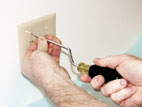
Some tools are advertised as "ergonomic" or are designed with ergonomic features. A tool becomes "ergonomic" only when it fits the task you are performing, and it fits your hand without causing awkward postures, harmful contact pressures, or other safety and health risks. If you use a tool that does not fit your hand or use the tool in a way it was not intended, you might develop an injury, such as carpal tunnel syndrome, tendonitis, or muscle strain. These injuries do not happen because of a single event, such as a fall. Instead, they result from repetitive movements that are performed over time or for a long period of time, which may result in damage to muscles, tendons, nerves, ligaments, joints, cartilage, spinal discs, or blood vessels.
Definitions
Awkward Postures - Postures that strain the neck, shoulders, elbows, wrists, hands, or back. Bending, stooping, twisting, and reaching, are examples of awkward postures.

Power Grip - The hand grip that provides maximum hand power for high force tasks. All the fingers wrap around the handle.
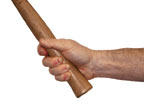
Contact Pressure - Pressure from a hard surface, point, or edge on any part of the body.
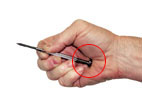
Pinch Grip - The hand grip that provides control for precision and accuracy. The tool is gripped between the thumb and the fingertips.
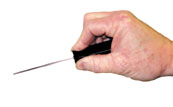
Single-Handle Tools - Tube-like tools measured by handle length and diameter.
Diameter - The length of a straight line through the center of the handle.
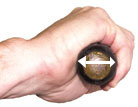
Double-Handle Tools - Plier-like tools measured by handle length and grip span.
Grip Span - The distance between the thumb and fingers when the tool jaws are open or closed.
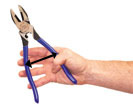
The cost of an injury can be high, especially if the injury prevents you from doing your job.
The best tool is one that:
- Fits the job you are doing
- Fits the work space available
- Reduces the force you need to apply
- Fits your hand
- Can be used in a comfortable work position
How do you know if you have a problem?
You may have a problem if you have any of these symptoms:
- Tingling
- Swelling in the joints
- Decreased ability to move
- Decreased grip strength
- Pain from movement, pressure, or exposure to cold or vibration
- Continual muscle fatigue
- Sore muscles
- Numbness
- Change in the skin color of your hands or fingertips
These symptoms may not appear immediately because they develop over weeks, months, or years. By then, the damage may be serious. Take action before you notice any symptoms.
Reduce your risk of injury by using these guidelines to select hand tools:
- Know your job
- Look at your work space
- Improve your work posture
- Review the "Tips for Selecting Hand Tools"
- Checklist: Select the Tool
Use the Checklist to select the best tool. The features listed on the Checklist correspond to the tips found on pages 8 to 11, "Tips for Selecting Hand Tools."
Cal/OSHA Consultation Service
Toll-free number: 1-800-963-9424 (California Only)
Download this and other Cal/OSHA publications at:
http://www.dir.ca.gov/dosh/puborder.asp
Delivering on the Nation's Promise: Safety and health at work for all people through prevention
To receive other information about occupational safety and health topics, call:
1-800-35-NIOSH (1-800-356-4674)
or visit the NIOSH Website
SAFER - HEALTHIER - PEOPLE

